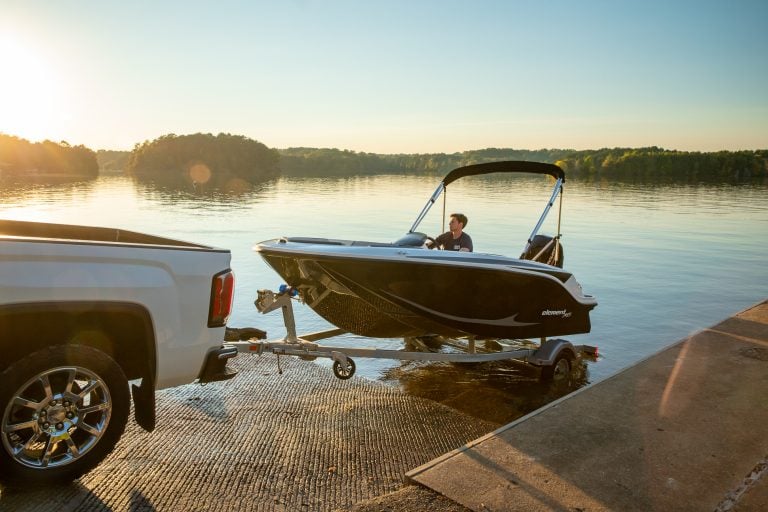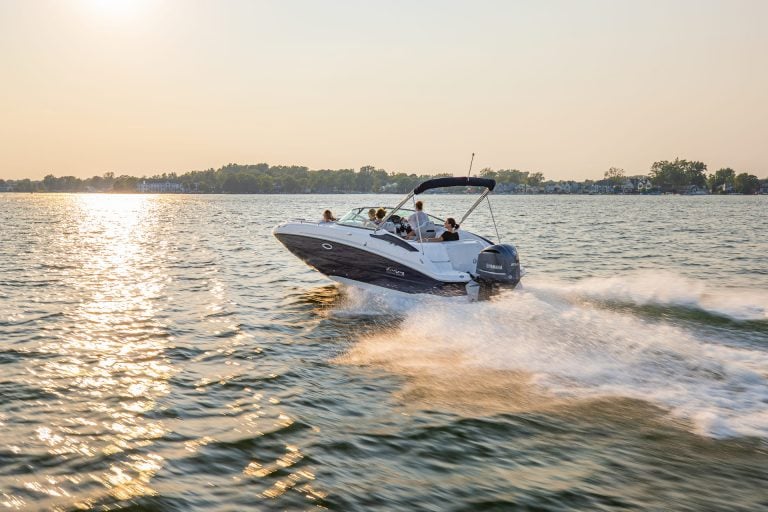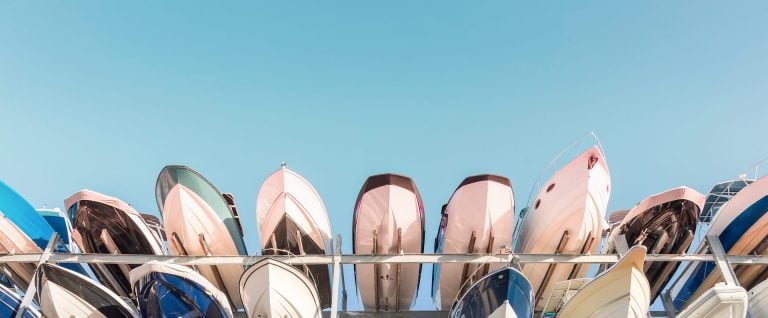Docking a boat can seem like a daunting task, but knowing what lines you need to tie can make the whole process run more smoothly. In this blog, we’ll outline how to tie a boat to a dock or in a slip, what lines and equipment you’ll need, the kinds of knots you need to know, and some helpful tips to keep your boat safe and secure.

There are several pieces of gear you’ll need in order to properly dock your boat.
The number of lines you need depends on where you dock. For mooring parallel to a dock, it’s common to use one bow line, one stern line, and two spring lines. For mooring in a slip, you’ll likely need two bow lines, two stern lines, and at least one spring line. Each docking situation varies and it’s important to tailor your approach to fit your specific boat and the dock or slip.
If you have your own dock, it’s a good idea to leave your lines tied to the dock cleats (and coiled neatly so no one trips). This will make it quicker and easier to tie your boat to the dock. Just remember to keep enough lines on your boat to dock anywhere else you might stop.
You should have a second full set of lines on your boat. It’s always a good idea to have extra lines on hand anyway, in case one breaks or you need additional lines to better secure your boat in stronger conditions.
If you’re mooring parallel to the dock, you’ll need to use one bow line and one stern line to secure either end of your boat, and two spring lines to keep your boat from moving back and forth. Unless you’re docking for an extended period of time or in rough conditions, these four lines are typically enough to safely tie up your boat.
Your bow line should run from the cleat on your bow to a dock cleat ahead of your boat. Similarly, your stern line should run from the cleat on your stern to a dock cleat behind your boat. Your spring lines will run diagonally between your boat and the dock, aft (backwards) from your bow and fore (forwards) from your stern, crossing each other in the middle.
If you’re docking in a slip, you will need to tie more lines than you would at a dock. Boats are often backed into slips, meaning that you’ll have the dock on one side and along the stern, and a piling on the other side of your bow. Use the lines to position your boat in the slip so it doesn’t hit into the dock or the boat docked in the other half of the slip.
First you’ll tie two bow lines, one from the boat cleat closest to the dock to the dock cleat near the bow. The other bow line will run from the boat cleat on the other side of the bow to the piling in the middle of the slip.
You’ll then tie at least one spring line, running from a boat cleat near the stern to a dock cleat near the bow; this will help you position the stern relative to the back of the slip, and keep your boat from hitting into the dock.
Finally, you’ll also tie two stern lines, using the boat cleats on either side of your stern.You’ll cross the two stern lines diagonally and tie them off to the opposite dock cleats at the back of the slip. This centers your stern and keeps it from moving back and forth.
If your slip doesn’t fit two boats and you have a dock on all three sides (instead of a piling on one), you’ll tie your boat just as you would if mooring parallel to the dock, but to both sides. You’ll tie two bow lines, two stern lines, and four spring lines.

If you're mooring in a slip, or at a dock that doesn’t have cleats, you’ll need to tie off your lines to a piling, or dock post. Tie your lines lower rather than higher on the piling to reduce the amount of strain on the wood.
There are several different kinds of knots you can use to secure your line to a piling, including a round turn and two half hitches, a clove hitch, and a bowline knot. A round turn and two half hitches is a common and trusted method that ties the line tightly around the piling. A bowline knot creates a loop that’s tied somewhat loosely around the piling; it’s also a safe and secure option. A clove hitch is another tight knot that can be used instead, although it might be slightly less secure and should be followed by additional half hitches.
In order to tie your lines to the cleat hitches on your boat and on the dock, you’ll need to master the cleat hitch. It’s a relatively simple knot that is strong enough to keep your boat safe and secure. The knot is similar to making a figure eight around the cleat and creates friction by securing the rope underneath itself.
For more information on tying a cleat hitch, check out another installment of Boating 101, How To Tie a Boat to a Dock Cleat.
#1 Tie lines that are long but tight
To keep your boat from moving around, tie tight, long lines. This might mean skipping a cleat or piling and choosing one that’s further away. Making your lines long is especially important in tidal waters, because long lines allow your boat more freedom to move up and down even with a tight line. Short lines are less forgiving and can hang your boat from the dock, causing it to capsize and damage the dock.
#2 Only tie breast lines temporarily
Breast lines are short lines tied from a cleat on the side of your boat to an adjacent dock cleat. They’re used to bring the boat right up against the dock, making it easier for passengers to board or disembark. Because they’re so short and tight, they should only be used temporarily, until everyone has gotten on or off the boat. This is particularly important in tidal waters — if the tide changes while a breast line is still tied, the boat can hang from the dock and capsize.
#3 Adjust line configuration for your boat or dock
Each boat and dock layout is different, so you’ll need to figure out the configuration that works best for you. For example, you might need to tie bow or stern lines that angle toward (not away from) your boat because of the length of your boat, the available cleats, or the length of the slip.
It’s important to use the right lines when docking your boat. For mooring parallel to a dock, you’ll likely need a bow line, a stern line, and two spring lines. To dock in a slip, you’ll typically use two bow lines, two stern lines, and a spring line.
For other helpful boating tips, check out more articles on our blog.


